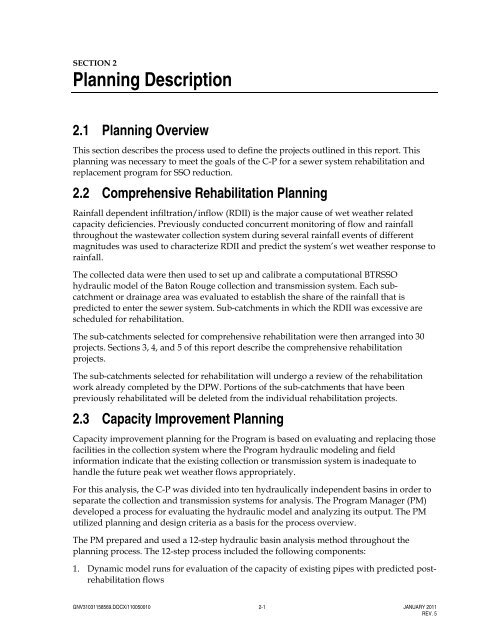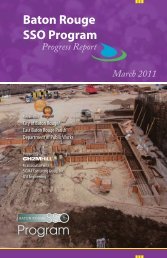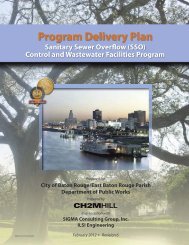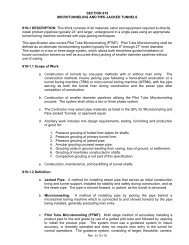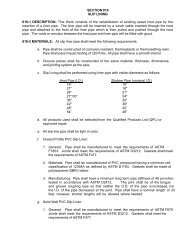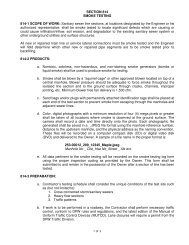- Page 1: Program Delivery Plan Sanitary Sewe
- Page 4 and 5: CONTENTS, CONTINUED Section Page 3.
- Page 6 and 7: CONTENTS, CONTINUED Section Page 5.
- Page 8 and 9: CONTENTS, CONTINUED Tables Page 3-2
- Page 10 and 11: CONTENTS, CONTINUED Figures Page ES
- Page 12 and 13: CONTENTS, CONTINUED Figures Page 5-
- Page 14 and 15: This page intentionally left blank.
- Page 16 and 17: EXECUTIVE SUMMARY Accommodate gr
- Page 18 and 19: Avenue K F 3rd 3rd 6th Lupine 9th 1
- Page 20 and 21: EXECUTIVE SUMMARY Station Facility
- Page 22 and 23: EXECUTIVE SUMMARY List of Completed
- Page 24 and 25: EXECUTIVE SUMMARY TABLE ES-3 List o
- Page 26 and 27: SECTION 1 Overview 1.1 Background T
- Page 28 and 29: SECTION 1. OVERVIEW 1.3.2 Capacity
- Page 30 and 31: TABLE 1-1 Project Funding Schedule
- Page 32 and 33: TABLE 1-1 Project Funding Schedule
- Page 34 and 35: TABLE 1-1 Project Funding Schedule
- Page 36 and 37: TABLE 1-1 Project Funding Schedule
- Page 38 and 39: TABLE 1-1 Project Funding Schedule
- Page 40 and 41: TABLE 1-1 Project Funding Schedule
- Page 42 and 43: FIGURE 1-1 Program Funding Schedule
- Page 44 and 45: FIGURE 1-2 Program Schedule Program
- Page 46 and 47: FIGURE 1-2 Program Schedule Program
- Page 48 and 49: FIGURE 1-2 Program Schedule Program
- Page 52 and 53: SECTION 2. PLANNING DESCRIPTION imp
- Page 54 and 55: SECTION 3 South Basin Projects Sect
- Page 56 and 57: F 3rd Lupine Alba East Sunshine Elm
- Page 58 and 59: SECTION 3. SOUTH BASIN PROJECTS 3.1
- Page 60 and 61: Energy Whitter Lobdell Cyril Carter
- Page 62 and 63: Lobdell Crown Cyril Carter Lasalle
- Page 64 and 65: 48th 49th Elm Topaz Garnet Waverly
- Page 66 and 67: Brookstown Topaz Garnet Juban Evang
- Page 68 and 69: Burbank Wylie Kenilworth Kenilworth
- Page 70 and 71: Issac Cline Etta Campus Dean Lee Pr
- Page 72 and 73: Frances Harriet Monterrey Redondo C
- Page 74 and 75: SECTION 3. SOUTH BASIN PROJECTS 3.2
- Page 76 and 77: SECTION 3. SOUTH BASIN PROJECTS Gra
- Page 78 and 79: Marilyn Elizabeth Brocade Aletha Ma
- Page 80 and 81: SECTION 3. SOUTH BASIN PROJECTS Gra
- Page 82 and 83: SECTION 3. SOUTH BASIN PROJECTS 3.2
- Page 84 and 85: SECTION 3. SOUTH BASIN PROJECTS 3.2
- Page 86 and 87: SECTION 3. SOUTH BASIN PROJECTS Gra
- Page 88 and 89: SECTION 3. SOUTH BASIN PROJECTS Sco
- Page 90 and 91: Whitter Monet Lobdell Lanier Cyril
- Page 92 and 93: I-10 Essen Heights Essen Heights #I
- Page 94 and 95: Burbank PS58_n6 !R Lochness Clover
- Page 96 and 97: # Pollard Picardy Blair Summa # PS3
- Page 98 and 99: Samoa PS58A PS58 # Essen Park One C
- Page 100 and 101:
Corporate Woodstock Moniteau Bocage
- Page 102 and 103:
SECTION 3. SOUTH BASIN PROJECTS TAB
- Page 104 and 105:
SECTION 3. SOUTH BASIN PROJECTS 3.2
- Page 106 and 107:
SECTION 3. SOUTH BASIN PROJECTS Gra
- Page 108 and 109:
SECTION 3. SOUTH BASIN PROJECTS TAB
- Page 110 and 111:
SECTION 3. SOUTH BASIN PROJECTS 3.2
- Page 112 and 113:
Mimosa Orchid Poplar Tupello Perkin
- Page 114 and 115:
SECTION 3. SOUTH BASIN PROJECTS 3.3
- Page 116 and 117:
Sassafras Antioch Shady Grove Vigne
- Page 118 and 119:
Inniswold Idlewood Parkbriar Cypres
- Page 120 and 121:
SECTION 3. SOUTH BASIN PROJECTS 3.4
- Page 122 and 123:
SECTION 3. SOUTH BASIN PROJECTS 3.4
- Page 124 and 125:
SECTION 3. SOUTH BASIN PROJECTS 3.4
- Page 126 and 127:
SECTION 3. SOUTH BASIN PROJECTS 3.4
- Page 128 and 129:
SECTION 3. SOUTH BASIN PROJECTS 3.4
- Page 130 and 131:
SECTION 3. SOUTH BASIN PROJECTS 3.4
- Page 132 and 133:
SECTION 3. SOUTH BASIN PROJECTS For
- Page 134 and 135:
SECTION 3. SOUTH BASIN PROJECTS TAB
- Page 136 and 137:
Antioch # # PS287 # Exchequer # PS3
- Page 138 and 139:
SECTION 3. SOUTH BASIN PROJECTS 3.4
- Page 140 and 141:
SECTION 3. SOUTH BASIN PROJECTS 3.4
- Page 142 and 143:
SECTION 3. SOUTH BASIN PROJECTS 3.4
- Page 144 and 145:
SECTION 3. SOUTH BASIN PROJECTS 3.4
- Page 146 and 147:
SECTION 3. SOUTH BASIN PROJECTS For
- Page 148 and 149:
SECTION 3. SOUTH BASIN PROJECTS Blv
- Page 150 and 151:
Mike O'Neal Elliot # # # Toulon # R
- Page 152 and 153:
SECTION 3. SOUTH BASIN PROJECTS 3.5
- Page 155:
N Feet 0 50 100 150 200 Legend IAP
- Page 158 and 159:
SECTION 3. SOUTH BASIN PROJECTS
- Page 160 and 161:
SECTION 3. SOUTH BASIN PROJECTS wei
- Page 162 and 163:
SECTION 4. CENTRAL BASIN PROJECTS T
- Page 164 and 165:
3rd Lupine 9th 15th 15th 16th 17th
- Page 166 and 167:
SECTION 4. CENTRAL BASIN PROJECTS T
- Page 168 and 169:
10th Emma Brickyard Aztec Gila St P
- Page 170 and 171:
21st 22nd West East 47th 48th 49th
- Page 172 and 173:
I-110 28th Brookstown Topaz Garnet
- Page 174 and 175:
9th 10th 15th 17th 18th 19th 21st 2
- Page 176 and 177:
SECTION 4. CENTRAL BASIN PROJECTS G
- Page 178 and 179:
SECTION 4. CENTRAL BASIN PROJECTS 4
- Page 180 and 181:
SECTION 4. CENTRAL BASIN PROJECTS G
- Page 182 and 183:
3rd 5th Royal 9th 15th 17th 18th 18
- Page 184 and 185:
3rd 9th 12th 22nd 28th 29th West Ea
- Page 186 and 187:
SECTION 4. CENTRAL BASIN PROJECTS G
- Page 188 and 189:
South §¨¦ I-110 Terrace Myrtle C
- Page 190 and 191:
SECTION 4. CENTRAL BASIN PROJECTS P
- Page 192 and 193:
SECTION 4. CENTRAL BASIN PROJECTS 4
- Page 194 and 195:
SECTION 4. CENTRAL BASIN PROJECTS 4
- Page 196 and 197:
SECTION 4. CENTRAL BASIN PROJECTS 4
- Page 198 and 199:
Aster # Stadium Iowa Iowa # PS1 Sta
- Page 200 and 201:
SECTION 4. CENTRAL BASIN PROJECTS T
- Page 202 and 203:
SECTION 4. CENTRAL BASIN PROJECTS T
- Page 204 and 205:
SECTION 5. NORTH BASIN PROJECTS Thi
- Page 206 and 207:
F 3rd 3rd Lupine Truth Alba East Su
- Page 208 and 209:
Chinn Helene Sussex Golden Muse Elm
- Page 210 and 211:
SECTION 5. NORTH BASIN PROJECTS Thi
- Page 212 and 213:
SECTION 5. NORTH BASIN PROJECTS Gra
- Page 214 and 215:
See Inset
- Page 216 and 217:
F Chinn Golden Sunshine Troy # Aven
- Page 218 and 219:
SECTION 5. NORTH BASIN PROJECTS Thi
- Page 220 and 221:
SECTION 5. NORTH BASIN PROJECTS TAB
- Page 222 and 223:
Hiawatha Mengel Sanchez Goudchaux K
- Page 224 and 225:
SECTION 5. NORTH BASIN PROJECTS Thi
- Page 226 and 227:
SECTION 5. NORTH BASIN PROJECTS TAB
- Page 228 and 229:
SECTION 5. NORTH BASIN PROJECTS 5.4
- Page 230 and 231:
Sullivan Shoe Creek Lazy Lake Hoope
- Page 232 and 233:
SECTION 5. NORTH BASIN PROJECTS TAB
- Page 234 and 235:
SECTION 5. NORTH BASIN PROJECTS 5.4
- Page 236 and 237:
SECTION 5. NORTH BASIN PROJECTS 5.4
- Page 238 and 239:
SECTION 5. NORTH BASIN PROJECTS 5.4
- Page 240 and 241:
SECTION 5. NORTH BASIN PROJECTS jus
- Page 242 and 243:
Blackwater Acres Hubbs Sullivan Car
- Page 244 and 245:
SECTION 5. NORTH BASIN PROJECTS 5.4
- Page 246 and 247:
Greenway Rome Airway Vega Monterrey
- Page 248 and 249:
SECTION 5. NORTH BASIN PROJECTS TAB
- Page 250 and 251:
SECTION 5. NORTH BASIN PROJECTS 5.4
- Page 252 and 253:
SECTION 5. NORTH BASIN PROJECTS 5.4
- Page 254 and 255:
SECTION 5. NORTH BASIN PROJECTS 052
- Page 256 and 257:
SECTION 5. NORTH BASIN PROJECTS TAB
- Page 258 and 259:
SECTION 5. NORTH BASIN PROJECTS 5.4
- Page 260 and 261:
SECTION 5. NORTH BASIN PROJECTS TAB
- Page 262 and 263:
SECTION 5. NORTH BASIN PROJECTS 5.4
- Page 264 and 265:
# PRIVATETMT # Port Hudson-Pride !R
- Page 266 and 267:
Burrel # PRIVATETMT PS357 # Port Hu
- Page 268 and 269:
Foster Cora # # Yancy # PS78 # # PS
- Page 270 and 271:
SECTION 5. NORTH BASIN PROJECTS TAB
- Page 272 and 273:
SECTION 5. NORTH BASIN PROJECTS Thi
- Page 274 and 275:
SECTION 5. NORTH BASIN PROJECTS Pla
- Page 276 and 277:
SECTION 5. NORTH BASIN PROJECTS TAB
- Page 278 and 279:
SECTION 6. EMERGENCY GENERATORS TAB
- Page 280 and 281:
SECTION 6. EMERGENCY GENERATORS TAB
- Page 282 and 283:
SECTION 6. EMERGENCY GENERATORS TAB
- Page 284 and 285:
SECTION 6. EMERGENCY GENERATORS TAB
- Page 286 and 287:
SECTION 6. EMERGENCY GENERATORS TAB
- Page 288 and 289:
SECTION 6. EMERGENCY GENERATORS TAB
- Page 290 and 291:
SECTION 6. EMERGENCY GENERATORS Thi
- Page 293 and 294:
APPENDIX A Existing Pump Stations a
- Page 295 and 296:
APPENDIX A Existing Pump Stations a
- Page 297 and 298:
APPENDIX A Existing Pump Stations a
- Page 299 and 300:
APPENDIX A Existing Pump Stations a
- Page 301:
Appendix B PDP Lift Stations
- Page 304 and 305:
APPENDIX B PDP Lift Stations; Baton
- Page 306 and 307:
APPENDIX B PDP Lift Stations; Baton
- Page 308 and 309:
This page intentionally left blank.
- Page 310 and 311:
SECTION 7. SUPERVISORY CONTROL AND
- Page 312 and 313:
SECTION 7. SUPERVISORY CONTROL AND
- Page 314:
SECTION 7. SUPERVISORY CONTROL AND


